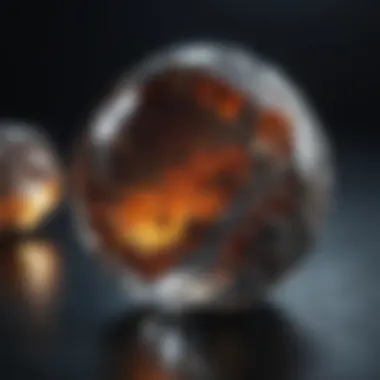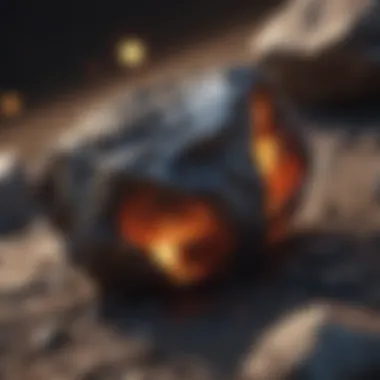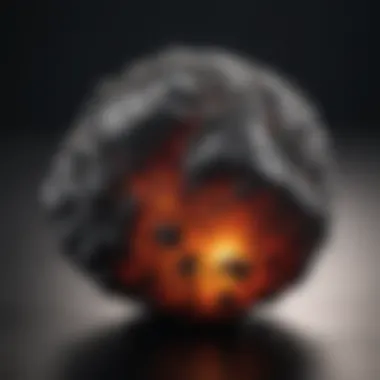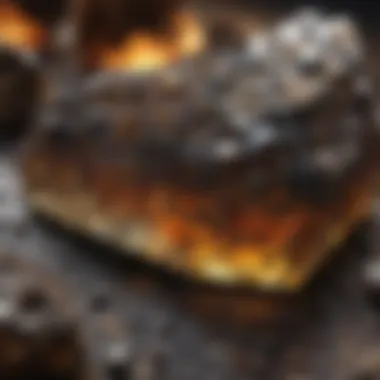Unveiling the Intriguing Varieties of Meteorite Stones


Overview of Meteorite Stones
As we embark on a journey to explore the enigmatic realm of meteorite stones, it is essential to grasp the marvels that lie beyond our terrestrial boundaries. Meteorite stones, fragments of asteroids or other extraterrestrial bodies that survive the fiery journey through Earth's atmosphere, offer a captivating glimpse into the vast universe. These cosmic travelers intrigue gemstone enthusiasts and curious minds alike with their unique composition and origin. Let's unravel the mysteries of meteorite stones, delving into their types, characteristics, and significance.
Composition and Origins of Meteorite Stones
The composition of meteorite stones varies depending on their classification - iron, stony-iron, or stony meteorites. Iron meteorites, primarily composed of iron and nickel, exhibit a distinctive metallic luster and are often heavy due to their dense composition. Stony-iron meteorites, consisting of a combination of silicate minerals and nickel-iron metal, showcase an intriguing blend of textures. Stony meteorites, composed mainly of silicate minerals, encompass a diverse range of subtypes, each with its peculiar characteristics. These meteorite stones originate from asteroids, Mars, or the Moon, offering a glimpse into the geological diversity of celestial bodies.
Types and Classification of Meteorite Stones
Exploring the realm of meteorite stones unveils a rich tapestry of types and classifications that intrigue both geology enthusiasts and collectors. Iron meteorites, classified based on their crystalline structure, showcase patterns that are a testament to the turbulent history of the early solar system. Stony-iron meteorites, encompassing the renowned pallasites and mesosiderites, offer a blend of metal and silicate minerals, evoking wonder with their unique structures. Stony meteorites, ranging from chondrites to achondrites, present a diverse array of mineral compositions that reflect their distinct origins and formation processes. Understanding the types and classifications of meteorite stones enhances appreciation for these extraterrestrial treasures.
Significance and Cultural Relevance of Meteorite Stones
Meteorite stones have captivated human imagination for centuries, with cultures worldwide attributing mystical properties to these celestial relics. From ancient beliefs in their protective powers to modern-day scientific fascination with their isotopic compositions, meteorite stones hold a profound significance. Jewelry designers draw inspiration from the aesthetic appeal of meteorite stones, incorporating them into exquisite pieces that symbolize a link between Earth and the cosmos. Museums display meteorite specimens to educate and inspire, showcasing these extraterrestrial gems as windows into the cosmic history. Exploring the cultural relevance and significance of meteorite stones enriches the narrative of these celestial wonders.
Introduction
Taking a mesmerizing journey into the realm of meteorite stones unlocks a doorway to the mysteries of the cosmos awaiting to be unraveled. This article meticulously dissects the various facets of meteorite stones, transcending mere geological formations to introduce readers to relics of space that hold stories older than time itself. Delving into the crucial essence of meteorite stones becomes imperative as these extraterrestrial gems bear witness to celestial events that shape our understanding of the universe.
Contemplating the genesis of meteorite stones entails a contemplation of our place in the vast expanse of existence. The allure of these enigmatic rocks transcends their material composition, beckoning us to ponder the origins of these celestial wanderers that graciously grace our planet. By embarking on this journey, we embark on a voyage through space and time, connecting with the very fabric of the cosmos that intertwines with our earthly existence.
Understanding Meteorite Stones
In the realm of gemology and geology, delving into the intricate domain of meteorite stones holds significant importance for enthusiasts, collectors, and researchers alike. Meteorite stones, as the remnants of celestial bodies that have traversed vast cosmic distances to Earth, offer a unique glimpse into the mysteries of our universe. Understanding the origin, structure, and composition of meteorite stones provides valuable insights into the formation and evolution of celestial bodies, shedding light on the organic processes that govern our solar system's dynamics. By exploring the diverse array of meteorite types, ranging from iron meteorites to stony-iron meteorites, gemstone enthusiasts can unravel the complex narratives encoded within these extraterrestrial gems.
Defining Meteorite Stones


Navigating the intricate terrain of meteorite stones requires a precise understanding of their defining characteristics. Meteorite stones are extraterrestrial objects that have survived the fiery passage through Earth's atmosphere, impacting the planet's surface as meteorites. Distinguished by their fusion crusts and unique markings, meteorite stones exhibit key features that set them apart from terrestrial rocks. The classification of meteorites is based on their mineral composition, structure, and isotopic signatures, enabling researchers to categorize these otherworldly specimens within distinct groups based on their elemental makeup.
Formation of Meteorite Stones
The formation of meteorite stones unfolds as a cosmic drama that spans billions of years, beginning with the birth of stars and the subsequent processes that lead to the creation of planets. Meteorite stones originate from asteroids, comets, and planetary bodies within our solar system, culminating in their ejection into space due to cosmic collisions or gravitational disturbances. These celestial wanderers travel through the void of space before encountering Earth's gravitational pull, hurtling towards our planet with immense velocity. The fiery entry into Earth's atmosphere and the subsequent impact with the planet's surface mark the final chapter of a meteorite's tumultuous journey through the cosmos.
Composition of Meteorite Stones
At the core of meteorite stones lies a complex tapestry of elements, isotopes, and minerals that unveil their extraterrestrial origins. Composed of metallic iron, nickel, silicates, and other exotic materials, meteorite stones present a diverse range of compositions that reflect their diverse parent bodies. Iron meteorites, primarily consisting of iron-nickel alloys, offer insights into the core regions of differentiated planetary bodies. In contrast, stony meteorites, rich in silicate minerals and organic compounds, provide windows into the crust and mantle compositions of celestial bodies. Stony-iron meteorites, bridging the gap between metal-rich and silicate-rich meteorites, showcase a fusion of materials that hint at tumultuous cosmic histories. By unraveling the compositional puzzles embedded within meteorite stones, researchers can decode the ancient narratives of our solar system's formation and evolution.
Types of Meteorite Stones
In this section, we delve deep into the different varieties of meteorite stones, offering a detailed look into their unique characteristics and significance. The exploration of various types of meteorite stones in this article serves as a crucial foundation for understanding the diverse nature of these extraterrestrial gems. By examining iron meteorites, stony meteorites, stony-iron meteorites, and other rare types, readers gain valuable insights into the complex world of meteorite stones.
Iron Meteorites
Iron meteorites are a fascinating category within meteorite stones, known for their high iron content and unique crystalline structures. Within iron meteorites, three main subtypes stand out: Octahedrites, Hexahedrites, and Ataxites. Each of these subcategories possesses distinct characteristics that make them valuable additions to this article's exploration of meteorite types.
Octahedrites
Octahedrites are characterized by their distinctive octahedral crystalline structure, making them visually striking and scientifically significant. The geometric arrangement of these crystals enhances their appeal to collectors and researchers alike. Despite their beauty, octahedrites present challenges due to their susceptibility to rusting over time, requiring specialized care to preserve their integrity.
Hexahedrites
Hexahedrites, with their cubic crystal structure, offer a different allure compared to other iron meteorites. The geometric precision of hexahedrites makes them unique in appearance, attracting interest from collectors seeking visually striking pieces. However, their crystalline structure also poses challenges in terms of preservation, requiring careful handling and storage to maintain their aesthetic and scientific value.
Ataxites
Ataxites diverge from the typical crystalline structures seen in other iron meteorites, displaying an irregular arrangement of nickel and iron atoms. This randomness in composition gives ataxites a distinct visual appeal, often characterized by intricate patterns and textures. While their unique nature makes ataxites prized possessions for collectors, their composition also makes them vulnerable to corrosion, necessitating proper conservation methods.


Stony Meteorites
Moving beyond iron meteorites, stony meteorites form another essential category in the realm of meteorite stones. Chondrites, Achondrites, and Carbonaceous Chondrites represent notable subtypes within this group, each offering unique insights into the composition and formation of these extraterrestrial wonders.
Chondrites
Chondrites are the most common type of meteorite, known for their primitive composition that dates back to the early solar system. Their high abundance makes them valuable for scientific research, providing essential clues about the formation and evolution of celestial bodies. Collectors often appreciate chondrites for their historical significance and diverse classifications based on metal content and texture.
Achondrites
Achondrites, unlike chondrites, lack the presence of chondrules, suggesting a differentiated origin within larger celestial bodies. This differentiation results in unique mineral compositions and textures not found in chondrites, offering researchers a glimpse into differentiated planetary bodies' geologic processes. Despite their rarity compared to chondrites, achondrites are prized for their scientific value and potential insights into the early solar system's dynamics.
Carbonaceous Chondrites
Carbonaceous chondrites represent a specialized subtype of meteorites rich in carbon compounds, amino acids, and water-bearing minerals. These unique features make them invaluable for studying organic chemistry and the potential sources of life's building blocks in the universe. By elucidating the role of carbonaceous chondrites in the cosmic puzzle, researchers deepen their understanding of astrobiology and the possibilities for life beyond Earth.
Stony-Iron Meteorites
The fusion of stony and iron components in meteorites results in stony-iron meteorites, a distinct class known for remarkable diversity and compositions. Pallasites, Mesonites, and Iron-Acide Stony Meteorites exemplify the intricate blend of stony and metallic elements found in these captivating extraterrestrial treasures.
Pallasites
Pallasites feature olivine crystals suspended in a metallic matrix, creating a mesmerizing visual contrast between the green crystals and metallic background. The aesthetic appeal of pallasites, combined with their rarity, makes them highly sought after by collectors and researchers interested in the complex interplay between stony and iron components in meteorites.
Mesonites
Mesonites present a unique combination of silicate minerals and iron-nickel alloys, enriching the stony-iron meteorite category with their diverse compositions. The presence of silicate inclusions within metallic matrices offers scientists valuable insights into the processes that lead to the formation of stony-iron meteorites, shedding light on the dynamic nature of asteroidal bodies in the early solar system.


Iron-Acide Stony Meteorites
Iron-Acide Stony Meteorites, distinguished by their high iron content and mineralogical complexity, occupy a significant niche in meteorite classification. The coexistence of stony and iron components in these meteorites poses intriguing questions about their formation and geological history. By exploring the unique features of Iron-Acide Stony Meteorites, researchers deepen their knowledge of the planetary materials present in the asteroid belt and their implications for understanding solar system evolution.
Other Rare Types
Beyond the well-known categories, meteorite stones encompass other rare types like Lunar Meteorites, Martian Meteorites, and Enstatite Chondrites, each offering distinctive insights into planetary geology and cosmic phenomena. The study of these exceptional meteorites contributes significantly to our understanding of celestial bodies beyond Earth and the complex processes that shape our solar system.
Lunar Meteorites
Lunar meteorites, as fragments of the Moon's surface, provide scientists with tangible samples of lunar geology for study and analysis. The unique compositions of lunar rocks captured in these meteorites offer valuable data for unraveling the Moon's geological history and its relationship to Earth. Collectors and researchers alike are drawn to lunar meteorites for their intrinsic connection to Earth's closest celestial neighbor and the mysteries they hold about lunar evolution.
Martian Meteorites
Martian meteorites, originating from Mars, offer valuable insights into the Red Planet's geological composition and history. By studying these Martian rocks, scientists gain vital information about Mars' surface conditions, potential for past habitability, and geological evolution. The discovery of Martian meteorites on Earth ignites curiosity about the possibility of life on Mars and the shared geological processes shaping both Earth and the Red Planet.
Enstatite Chondrites
Enstatite chondrites, characterized by their unique mineralogy and low iron content, represent a rare and scientifically significant class of meteorites. The composition of enstatite chondrites offers valuable clues about the conditions prevalent in the early solar system and the processes that led to the formation of diverse meteorite types. As researchers unravel the mysteries of enstatite chondrites, they gain deeper insights into the primordial materials that coalesced to form the planets and asteroids in our solar system.
This comprehensive exploration of meteorite stone types provides a foundational understanding of the diverse and captivating world of these extraterrestrial gems. By delving into the intricacies of iron meteorites, stony meteorites, stony-iron meteorites, and other rare classifications, readers embark on a journey of discovery that enlightens and fascinates, revealing the remarkable diversity and scientific significance of meteorites that continue to inspire curiosity and wonder in gemstone enthusiasts, collectors, and researchers alike.
Characteristics and Identification
Physical Characteristics
Meteorite stones boast a wide range of physical characteristics that set them apart from terrestrial rocks. Their signature features include regmaglypts, or thumbprint-like markings, caused by ablation during atmospheric entry. The fusion crust, a glassy coating formed by intense heat, serves as another distinctive trait. Different meteorite classifications exhibit various textures, from smooth to coarse, providing enthusiasts with a tactile experience unlike any other. Moreover, the presence of chondrules, tiny spherical mineral grains found in chondritic meteorites, adds to the allure and scientific interest of these cosmic wonders.
Identification Methods
To accurately identify meteorite stones, experts employ a combination of visual inspection, magnetism testing, and density measurements. Meteorites typically exhibit magnetic properties due to their high iron content, making magnetism a reliable method for preliminary identification. Density measurements, comparing the weight of the specimen in air and water, help determine its composition and potential classification. Advanced techniques, such as isotopic analysis and microscopic examination, further enhance the accuracy of identification, enabling experts to differentiate between meteorites and terrestrial rocks with precision.
Value and Rarity
The value of meteorite stones extends beyond their monetary worth, encompassing scientific significance and rarity. Meteorites hold intrinsic value as remnants of space, providing valuable insights into the history and composition of our solar system. Rarity plays a key role in determining the market value of meteorite stones, with certain types, like Pallasites and Lunar Meteorites, commanding higher prices due to their limited availability. Collectors and enthusiasts prize meteorites not only for their aesthetic appeal but also for their scarcity and unique origin, making them coveted additions to any gemstone collection.







